Snowy egret
The snowy egret (Egretta thula) is a small white heron. The genus name comes from the Provençal French for the little egret aigrette, a diminutive of aigron, "heron". The species name thula is the Araucano for the black-necked swan, applied to this species in error by Chilean naturalist Juan Ignacio Molina in 1782.[3]
| Snowy egret | |
|---|---|
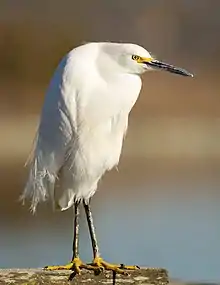 | |
| Scientific classification | |
| Kingdom: | Animalia |
| Phylum: | Chordata |
| Class: | Aves |
| Order: | Pelecaniformes |
| Family: | Ardeidae |
| Genus: | Egretta |
| Species: | E. thula |
| Binomial name | |
| Egretta thula (Molina, 1782) | |
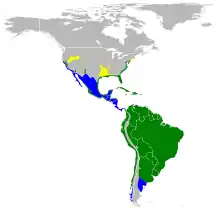 | |
| Range of E. thula Breeding range Year-round range Wintering range | |
| Synonyms | |
The snowy egret is the American counterpart to the very similar Old World little egret, which has become established in the Bahamas. At one time, the plumes of the snowy egret were in great demand as decorations for women's hats.[4] They were hunted for these plumes and this reduced the population of the species to dangerously low levels.[5] Now protected in the United States by law, under the Migratory Bird Treaty Act, this bird's population has rebounded.
Description
Adult snowy egrets are entirely white apart from the yellow lores between the long black bill and the eye, black legs, and bright yellow feet. The nape and neck bear long, shaggy plumes known as aigrettes.[6] Immature snowy egrets have duller, greenish legs.
Measurements:[7]
- Length: 22.1-26.0 in (56-66 cm)
- Weight: 13.1 oz (370 g)
- Wingspan: 39.4 in (100 cm)
Distribution and habitat
The snowy egret is native to North, Central and South America. It is present all year round in South America, ranging as far south as Chile and Argentina. It also occurs throughout the year in the West Indies, Florida and coastal regions of North and Central America. Elsewhere, in the southern part of the United States, it is migratory, breeding in California, Nevada, Utah, Colorado, Arizona, New Mexico, Texas, Louisiana and Mississippi. It is found in wetlands of many types; marshes, riverbanks, lakesides, pools, salt marshes and estuaries. It is not found at high altitudes nor generally on the coast.[6] The snowy egret has occurred as a vagrant in Europe, in Iceland, Scotland and the Azores.[8]
Diet
The birds eat fish, crustaceans, insects, small reptiles, snails, frogs, worms and crayfish. They stalk prey in shallow water, often running or shuffling their feet, flushing prey into view by swaying their heads, flicking their wings or vibrating their bills. They may also hover, or "dip-fish" by flying with their feet just above the water surface. Snowy egrets may also stand still and wait to ambush prey, or hunt for insects stirred up by domestic animals in open fields. They sometimes forage in mixed species groups.[5]
Breeding
Snowy egrets breed in mixed colonies, which may include great egrets, night herons, tricolored herons, little blue herons, cattle egrets, glossy ibises and roseate spoonbills. The male establishes a territory and starts building the nest in a tree, vines or thick undergrowth. He then attracts a mate with an elaborate courtship display which includes dipping up and down, bill raising, aerial displays, diving, tumbling and calling. The immediate vicinity of the nest is defended from other birds and the female finishes the construction of the nest with materials brought by the male. It is constructed from twigs, rushes, sedges, grasses, Spanish moss and similar materials and may be 15 in (38 cm) across. Up to six pale bluish-green eggs are laid which hatch after about 24 days. The young are altricial and covered with white down when first hatched. They leave the nest after about 22 days.[5]
Fossil finds
Fossils of the snowy egret have been reported from the Talara tar seeps of Peru and in Bradenton in Manatee County and Haile XIB in Alachua County in Florida, United States.[2] The deposits were dated to the Late Pleistocene.[9][10][11][12]
Status
In the early twentieth century, the snowy egret was hunted extensively for their long breeding plumes that fashionable ladies wore on their hats. This trade was ended in 1910 in North America but continued for some time in Central and South America. Since then populations have recovered.[5] The bird has a very wide range and the total population is large. No particular threats have been recognised and the population trend seems to be upwards, so the International Union for Conservation of Nature has assessed its conservation status as being of "least concern".[1]
Gallery
.jpg.webp) Head shot
Head shot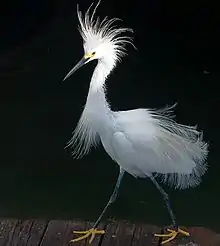 Plumage displayed
Plumage displayed Full breeding plumage
Full breeding plumage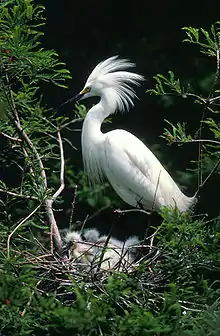 With chicks
With chicks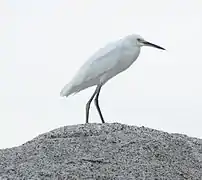 Tayrona national park, Colombia
Tayrona national park, Colombia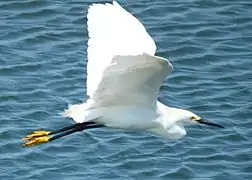 In flight
In flight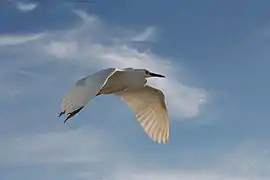 In flight
In flight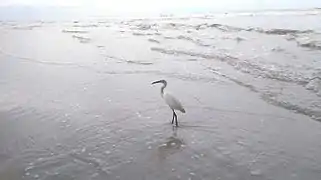 On the hunt, Daytona Beach, Florida, United States
On the hunt, Daytona Beach, Florida, United States.jpg.webp) Ponce Inlet Beach, Florida, United States.
Ponce Inlet Beach, Florida, United States.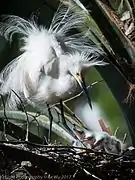 A snowy egret and its hatchlings in St. Augustine, FL.
A snowy egret and its hatchlings in St. Augustine, FL. Snowy egret chicks in St. Augustine, FL
Snowy egret chicks in St. Augustine, FL
References
- BirdLife International (2016). "Egretta thula". IUCN Red List of Threatened Species. IUCN. 2016: e.T22696974A93595536. doi:10.2305/IUCN.UK.2016-3.RLTS.T22696974A93595536.en. Retrieved 3 December 2019.
- Egretta thula at Fossilworks.org
- Jobling, 2010, p.143, 385
- Saikku, Mikko (Autumn 1990). "The Extinction of the Carolina Parakeet". Environmental History Review. 14 (3): 9–10. doi:10.2307/3984724. JSTOR 3984724.
- "Snowy Egret: Life History". All About Birds. TheCornellLab. Retrieved 29 March 2019.
- (T. S. Schulenberg, Editor). "Snowy egret (Egretta thula)". Cornell Lab of Ornithology: Neotropical Birds Online. Retrieved 28 November 2019.
- "Snowy Egret Identification, All About Birds, Cornell Lab of Ornithology". www.allaboutbirds.org. Retrieved 2020-09-26.
- "Twitchers flock to see UK's first snowy egret". The Scotsman. Retrieved 25 December 2018.
- Talara tar seeps at Fossilworks.org
- Bradenton at Fossilworks.org
- Haile XIB at Fossilworks.org
- Ligon, 1966
Bibliography
- Jobling, James A. 2010. The Helm Dictionary of Scientific Bird Names, 143, 385. Christopher Helm. Accessed 11 Dec 2019. ISBN 978-1-4081-2501-4
- Ligon, J.D. 1965. A Pleistocene avifauna from Haile, Florida. Bulletin of the Florida State Museum, Biological Sciences 10. 127-158. Accessed 11 Dec 2019.
Further reading
External links
| Wikimedia Commons has media related to Egretta thula. |
| Wikispecies has information related to Egretta thula. |
| Look up snowy egret in Wiktionary, the free dictionary. |
- Snowy Egret – Cornell Lab of Ornithology
- Snowy egret Egretta thula - USGS Patuxent Bird Identification InfoCenter
- "Snowy egret media". Internet Bird Collection.
- Snowy egret photo gallery at VIREO (Drexel University)
- Snowy egret species account at Neotropical Birds (Cornell Lab of Ornithology)
